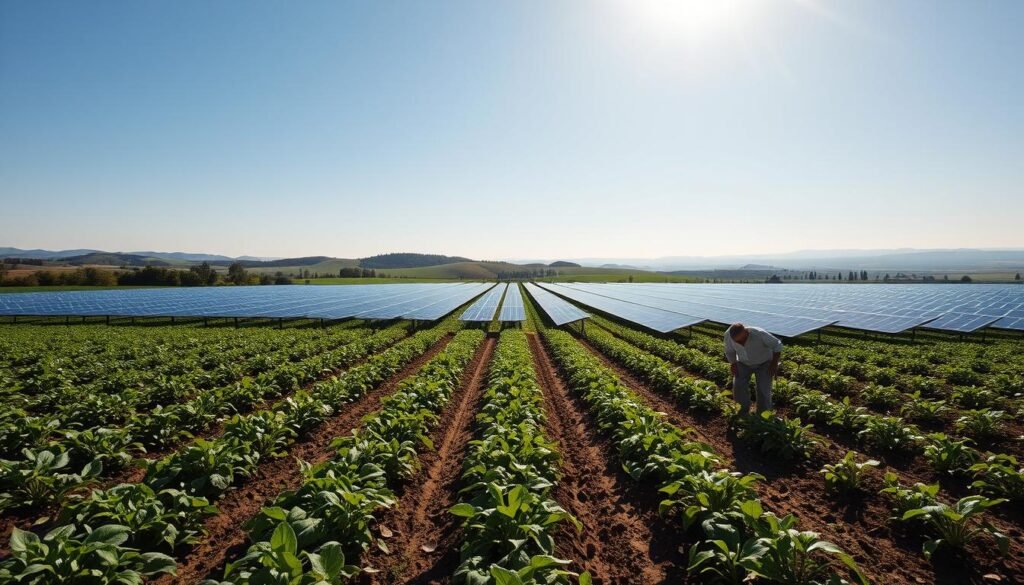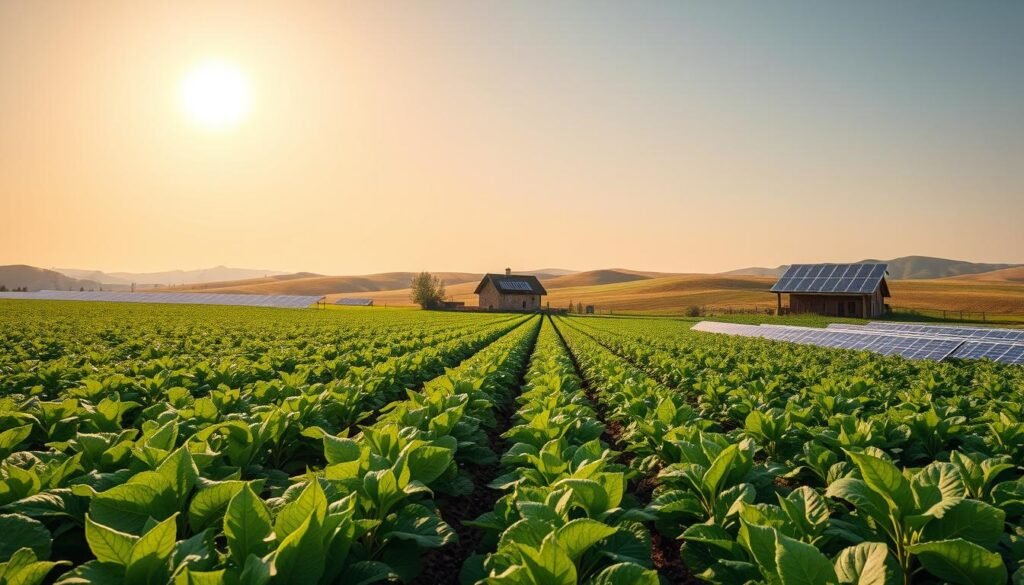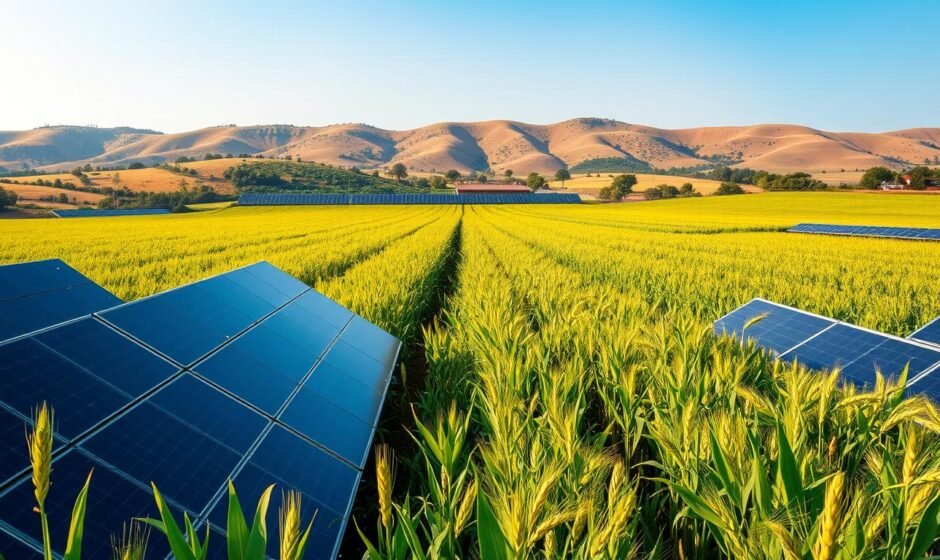Elon Musk once said, “The stone age did not end for lack of stone, and the oil age will end long before we run out of oil.” This quote highlights the change brought by agrivoltaic systems to sustainable farming. They combine solar panels and crops, solving food security, water scarcity, and climate change issues. For more on agrivoltaics, check out agri solar benefits and see how they benefit farmers.
Key Takeaways
- Agrivoltaic systems enable dual land use for food production and solar energy generation, maximising land use efficiency.
- Specific crops such as leafy vegetables thrive in shaded conditions, making them ideal for integration with solar panels.
- Agrivoltaic systems can lead to reduced evaporation rates by shielding crops from direct sunlight, contributing to water conservation.
- The Global Sustainable Agriculture Market is projected to grow from $14.37 billion in 2024 to $30.28 billion by 2030.
- Agrivoltaic systems help maximise land use efficiency by allowing dual land usage, which is valuable in areas with limited arable land.
Understanding Agrivoltaics
Agrivoltaics is a new way to mix sustainable energy farming with growing crops. It lets farmers make more money and help the planet. By putting solar panels on their land, farmers can grow better crops under the right shade.
The role of solar farming for agriculture is huge. With more people coming, we need to grow food and energy in new ways. Agrivoltaics helps farmers grow more food with less water and better soil.
Benefits of agrivoltaics include:
* More food from the land
* Less water used
* Healthier soil
* A chance to earn money in two ways
By using agrivoltaics, farmers can help the planet and do well financially.
Benefits for Farmers
As a farmer, you face many challenges in traditional farming. Combining solar panels with crops can help. It increases land use and brings in extra money. This way, you can make more profit from your land.
Some key benefits of agrivoltaics for farmers are:
- Increased land efficiency: Solar panels let you use more of your land for crops, reducing waste.
- Dual revenue streams: You can earn from crops and solar energy, boosting your income.
- Enhanced crop yields: Solar panels’ shade can help crops grow better and use less water, leading to healthier crops.
An agrivoltaic farm in Longmont, Colorado, is a great example. It powers about 300 homes and grows 15 crops. This shows how agrivoltaics can be a big income source for farmers and support green farming.
Electricity demand is set to rise in the future. Agrivoltaics can help meet this need while supporting green farming. By using agrivoltaics, you can lower your environmental impact, increase your profits, and help make food production more sustainable.
Environmental Advantages
Exploring agrivoltaics reveals many environmental benefits. It uses solar energy to cut down carbon footprint and support green farming. The solar agriculture benefits are clear, attracting both farmers and eco-advocates.
Studies show agrivoltaics can boost water use by up to 157% for some crops. This is vital in water-scarce areas. Solar panels also help keep soil moist, increasing it by about 15% compared to regular farming.
The main environmental pluses of agrivoltaics are:
- Less greenhouse gas emissions
- More efficient water use
- Encourages eco-friendly farming
- Helps biodiversity
Farmers using agrivoltaics help the planet while boosting their crops. As we move towards green energy, the value of agrivoltaic technology advantages will rise.
Economic Impact
Exploring agrivoltaic systems reveals their economic advantages. These systems offer agrovoltaic benefits like lower energy costs and higher profits. They let you grow crops and generate electricity on the same land, boosting your earnings and reducing traditional farming costs.
The benefits of solar panels in farming are clear. They provide a big income boost and cut down on carbon emissions. With the right setup, you can sell extra energy to the grid, creating a new income source. Plus, you might get incentives and grants to help with agrivoltaic adoption.
Some key economic perks of agrivoltaics are:
- Increased land productivity by 35%-73%
- Enhanced crop yield by 50%
- Reduced greenhouse gas emissions by about 2.77 tons/year

Investing in agrivoltaics can lead to a more sustainable farm future. It combines crop growth with electricity generation. This way, you can earn more, lessen environmental harm, and help make food production greener.
Challenges and Considerations
Thinking about agrivoltaic systems for your farm? It’s key to know the hurdles and things to think about. The start-up cost can be a big worry. But, agri solar benefits can make these costs more manageable over time. Also, how well your land fits and local rules can affect using agrivoltaics.
Some important things to keep in mind are:
- Initial investment costs: The cost of agrivoltaic systems is high, but they can pay for themselves over time.
- Land compatibility: Your land’s suitability for agrivoltaics is vital. Soil quality and sunlight are important factors.
- Regulatory barriers: Local laws and rules can influence using agrivoltaics. Knowing these is key before starting.
Despite the challenges, the agrivoltaic systems benefits for farmers are many. With careful planning, you can get past these issues and enjoy the benefits of this new tech.
Case Studies
Exploring solar farming for agriculture means looking at real examples. In the US, many projects show how sustainable energy farming works with farming. For example, the Soil Health Institute found that better soil care can boost crops and save water.
Some key examples are:
- Full Belly Farm in Yolo County, California, shows how solar panels can cut costs and improve efficiency.
- In Italy and Japan, solar panels help crops grow better and save water, thanks to smart water use.
These stories show how solar farming for agriculture can help crops grow more, save water, and support sustainable energy farming. By following these examples, farmers can make farming better for the planet and their wallets.
Technology Innovations
Exploring agrivoltaics reveals many benefits of mixing solar panels with crops. These systems are getting better thanks to new tech. Solar panels now make more energy, and smart farming tech boosts crop yields and cuts water use.
The future of agrivoltaics looks bright. Trends like AI and the Internet of Things will make these systems even better. These advancements will help farmers get more from their land and crops.
Some key benefits of agrivoltaics include:
- Increased land efficiency
- Dual revenue streams
- Enhanced crop yields
- Reduced water consumption
- Improved farm profitability
A lot of agrivoltaic projects focus on grazing and helping pollinators. This shows how these systems can help the environment. The Solar Energy Technologies Office is working to make solar panels cheaper for farmers.
By using new tech and combining solar panels with crops, you can enjoy many benefits. These include more land use and better farm profits. Keeping up with agrivoltaics trends and innovations is key.
| Benefits of Agrivoltaics | Description |
|---|---|
| Increased Land Efficiency | Agrivoltaic systems can lead to a 60% increase in land productivity |
| Improved Crop Yields | Productivity of crops under solar panels can increase by up to 30% |
| Reduced Water Consumption | Agrivoltaic systems can achieve up to a 40% reduction in water use |
How to Get Started
To start your journey in agrivoltaics, first check if your land is right for solar farming. Look at the soil, climate, and land shape. This helps you figure out how to best use solar technology in your farming.
Working with solar companies can be a big help. They know a lot about setting up and looking after solar panels. Also, looking for government help can make things cheaper. The U.S. Department of Agriculture (USDA) has programs like REAP to support farmers starting with agrivoltaics.
Here are some important steps to begin with agrivoltaics:
- Check if your land is good for solar farming
- Work with solar companies for advice
- Find government help to lower costs

By taking these steps and using solar technology, you can make your farming better. You’ll get the most out of solar farming benefits.
Sustainable Farming Practices
Organic farming and agrivoltaics together offer a new way to farm sustainably. By adding solar panels to farms, you can use the sun’s power and keep the land productive. This method not only uses land better but also supports green farming.
One big agrovoltaic benefit is better crop planning. Solar panels’ shade can protect crops from too much sun or rain. This leads to healthier plants and more food. For example, tomatoes and lettuce can grow up to 11% and 38% more under these systems.
Soil health is also improved. Agrivoltaic systems help keep the soil moist and prevent erosion. This can cut water use by 20%, which is great for dry areas. Healthier soil means crops are stronger and farming lasts longer.
Here are some tips to get the most out of these benefits:
- Pick crops that do well in shade, like leafy greens or some vegetables
- Plan when to plant crops based on the solar panel’s shade
- Use organic farming to make the soil richer and more diverse
For more on how solar tech can change farming, see this review of the AUECOOR 1200W Solar Wind Hybrid. It shows how solar tech can help farms.
By using these methods, you can make farming both effective and good for the planet. Agrivoltaics is more than just clean energy. It’s about creating a strong, green farm for the future.
Looking Ahead
The world is moving towards a greener future, and agrivoltaic systems will play a big role. They can power over 300 homes, like the 1.2-megawatt array at Jack’s Solar Garden. These systems are changing how we farm and make energy.
The future is looking good, with solar energy set to power 45% of U.S. electricity by 2050. As we need more renewable energy, using land wisely will be key. Agrivoltaics are a great way to do this. The U.S. might need 4 to 10 million acres for solar panels by 2050.
To make this happen, we need policies that help farmers and solar energy. Building a community of farmers, researchers, and innovators is also important. Together, we can make agrivoltaics work and create a better future for farming.




